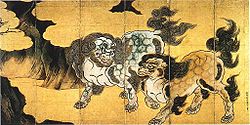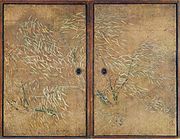
Kano Eitoku
Encyclopedia


History of Japan
The history of Japan encompasses the history of the islands of Japan and the Japanese people, spanning the ancient history of the region to the modern history of Japan as a nation state. Following the last ice age, around 12,000 BC, the rich ecosystem of the Japanese Archipelago fostered human...
and one of the most prominent patriarchs of the Kanō school
Kano school
The ' is one of the most famous schools of Japanese painting. The Kanō school of painting was the dominant style of painting until the Meiji period.It was founded by Kanō Masanobu , a contemporary of Sesshū and student of Shūbun...
of Japanese painting
Japanese painting
is one of the oldest and most highly refined of the Japanese visual arts, encompassing a wide variety of genres and styles. As with the history of Japanese arts in general, the long history of Japanese painting exhibits synthesis and competition between native Japanese aesthetics and adaptation of...
Born in Kyoto
Kyoto
is a city in the central part of the island of Honshū, Japan. It has a population close to 1.5 million. Formerly the imperial capital of Japan, it is now the capital of Kyoto Prefecture, as well as a major part of the Osaka-Kobe-Kyoto metropolitan area.-History:...
, Eitoku was the grandson of Kanō Motonobu
Kano Motonobu
Kanō Motonobu was a Japanese painter. He was a member of the Kanō school of painting.Kano Motonobu's father was Kanō Masanobu, the founder of the Kanō school....
(1476-1559), an official painter for the Ashikaga shogunate
Ashikaga shogunate
The , also known as the , was a Japanese feudal military regime, ruled by the shoguns of the Ashikaga clan.This period is also known as the Muromachi period and gets its name from Muromachi Street of Kyoto where the third shogun Ashikaga Yoshimitsu established his residence...
. He was recognized for his artistic talent at a very young age. Under Motonobu's guidance, he developed his grandfather's style, which had influence from Chinese painting
Chinese painting
Chinese painting is one of the oldest continuous artistic traditions in the world. The earliest paintings were not representational but ornamental; they consisted of patterns or designs rather than pictures. Early pottery was painted with spirals, zigzags, dots, or animals...
.
Collaborating with his father Shōei (1519-92), Eitoku painted the wall panels of the abbot's quarters in Jukōin, a subtemple of the Daitokuji
Daitokuji
Daitokuji may refer to:* Daitoku-ji, a Buddhist temple in Japan* Daitokuji , a Japanese name* B-ko Daitokuji, a prominent character in Project A-ko* Lyman Banner, a character in Yu-Gi-Oh! GX known as Daitokuji in Japan...
Zen monastic complex in Kyoto.
During his lifetime, Eitoku's patrons included Oda Nobunaga
Oda Nobunaga
was the initiator of the unification of Japan under the shogunate in the late 16th century, which ruled Japan until the Meiji Restoration in 1868. He was also a major daimyo during the Sengoku period of Japanese history. His opus was continued, completed and finalized by his successors Toyotomi...
and Toyotomi Hideyoshi
Toyotomi Hideyoshi
was a daimyo warrior, general and politician of the Sengoku period. He unified the political factions of Japan. He succeeded his former liege lord, Oda Nobunaga, and brought an end to the Sengoku period. The period of his rule is often called the Momoyama period, named after Hideyoshi's castle...
. His standing screen, sliding door, wall, and ceiling paintings decorated Nobunaga's Azuchi castle
Azuchi Castle
' was one of the primary castles of Oda Nobunaga. It was built from 1576 to 1579, on the shores of Lake Biwa, in Ōmi Province. Nobunaga intentionally built it close enough to Kyoto that he could watch over and guard the approaches to the capital, but, being outside the city, his fortress would be...
and Hideyoshi's residence in Kyoto and Osaka castle
Osaka Castle
is a Japanese castle in Chūō-ku, Osaka, Japan.Originally called Ozakajō, it is one of Japan's most famous castles, and played a major role in the unification of Japan during the sixteenth century of the Azuchi-Momoyama period.-Description:...
. Contemporary accounts indicate that Eitoku was one of the most highly sought-after artists of his time, and received many wealthy and powerful patrons. Maintaining the preeminence of the Kanō School was not merely an artistic feat, but an organizational and political one also. Eitoku was able to secure a steady stream of commissions and an efficient workshop of students and assistants, and at one point successfully intercepted a warlord's commission of the rival Hasegawa studio.
His signal contribution to the Kanō repertoire was the so-called "monumental style" (taiga), characterized by bold, rapid brushwork, an emphasis on foreground, and motifs that are large relative to the pictorial space. The traditional account for this style, codified by Eitoku's great-grandson Kanō Einō (1631-97) in his History of Japanese Painting (Honcho gashi), is that it resulted partly from the exigencies of Eitoku's busy schedule, and that it embodied the martial and political bravura of the warlords, Nobunaga and Hideyoshi.
Unfortunately, most of his works were destroyed in the turmoil of the Sengoku period
Sengoku period
The or Warring States period in Japanese history was a time of social upheaval, political intrigue, and nearly constant military conflict that lasted roughly from the middle of the 15th century to the beginning of the 17th century. The name "Sengoku" was adopted by Japanese historians in reference...
. However, those that do still exist provide testimony to his talent, to the power and wealth of his patrons Nobunaga and Hideyoshi, and to the magnificence of Azuchi-Momoyama culture.
External links
- National Archives of JapanNational Archives of JapanThe preserve Japanese government documents and historical records and make them available to the public. Although Japan's reverence for its unique history and art is well documented and illustrated by collections of art and documents, there is almost no archivist tradition...
: Ryukyu Chuzano ryoshisha tojogyoretsu, scroll illustrating procession of Ryukyu emissary to Edo, 1710 (Hōei 7).

